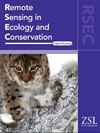Quantifying aboveground herbaceous biomass in grassy ecosystems: a comparison of field and high‐resolution UAV‐LiDAR approaches
IF 4.3
2区 环境科学与生态学
Q1 ECOLOGY
引用次数: 0
Abstract
Grassy ecosystems cover >25% of the world's land surface area. The abundance of herbaceous vegetation in these systems directly impacts a variety of ecological processes, including carbon sequestration, regulation of water and nutrient cycling, and support of grazing wildlife and livestock. Efforts to quantify herbaceous biomass, however, are often limited by a trade‐off between accuracy and spatial scale. Here, we describe a method for using Light Detection and Ranging (LiDAR) to estimate continuous aboveground biomass (AGB) at sub‐meter resolutions over large (10–10 000 ha) spatial scales. Across two African savanna ecosystems, we compared field‐ and LiDAR‐derived structural metrics—including measures of vegetation height and volume—with destructively harvested AGB by aligning our geospatial data with the location of harvested quadrats. Using this combination of approaches, we develop scaling equations to estimate spatially continuous herbaceous AGB over large areas. We demonstrate the utility of this method using a long‐term, large herbivore exclosure experiment as a case study and comprehensively compare common field‐ and LiDAR‐derived metrics for estimating herbaceous AGB. Our results indicate that UAV‐borne LiDAR provides comparable accuracy to standard field methods but over considerably larger areas. Nearly every measure of vegetation structure we quantified using LiDAR provided estimates of AGB that were comparable in accuracy (草地生态系统中地上草本生物量的量化:野外和高分辨率无人机-激光雷达方法的比较
草地生态系统覆盖了世界陆地表面面积的25%。这些系统中丰富的草本植被直接影响各种生态过程,包括碳固存、水和养分循环的调节以及对放牧野生动物和牲畜的支持。然而,量化草本生物量的努力往往受到准确性和空间尺度之间权衡的限制。在这里,我们描述了一种使用光探测和测距(LiDAR)在大(10-10 000公顷)空间尺度上以亚米分辨率估计连续地上生物量(AGB)的方法。在两个非洲稀树草原生态系统中,我们通过将我们的地理空间数据与收获样方的位置对齐,将野外和激光雷达获得的结构度量(包括植被高度和体积的测量)与破坏性收获的AGB进行了比较。利用这些方法的组合,我们开发了尺度方程来估计大面积上的空间连续草本AGB。我们通过一个长期的大型草食动物封闭实验来证明这种方法的实用性,并全面比较了普通野外和激光雷达导出的用于估计草本植物AGB的指标。我们的研究结果表明,无人机机载激光雷达提供与标准现场方法相当的精度,但覆盖范围要大得多。我们使用激光雷达量化的几乎所有植被结构测量都提供了精度相当的AGB估计(R2 >;0.6)到我们评估的常用字段方法套件。然而,我们两个站点之间的显著差异表明,对于精确估计绝对生物量是优先考虑的应用,无论采用何种方法,都有必要对破坏性收获进行特定站点的参数化。随着全球高分辨率遥感数据的不断增加,我们的研究结果表明,即使在缺乏补充的野外数据的情况下,也可以使用许多草本植被结构测量来准确地比较AGB。
本文章由计算机程序翻译,如有差异,请以英文原文为准。
求助全文
约1分钟内获得全文
求助全文
来源期刊

Remote Sensing in Ecology and Conservation
Earth and Planetary Sciences-Computers in Earth Sciences
CiteScore
9.80
自引率
5.50%
发文量
69
审稿时长
18 weeks
期刊介绍:
emote Sensing in Ecology and Conservation provides a forum for rapid, peer-reviewed publication of novel, multidisciplinary research at the interface between remote sensing science and ecology and conservation. The journal prioritizes findings that advance the scientific basis of ecology and conservation, promoting the development of remote-sensing based methods relevant to the management of land use and biological systems at all levels, from populations and species to ecosystems and biomes. The journal defines remote sensing in its broadest sense, including data acquisition by hand-held and fixed ground-based sensors, such as camera traps and acoustic recorders, and sensors on airplanes and satellites. The intended journal’s audience includes ecologists, conservation scientists, policy makers, managers of terrestrial and aquatic systems, remote sensing scientists, and students.
Remote Sensing in Ecology and Conservation is a fully open access journal from Wiley and the Zoological Society of London. Remote sensing has enormous potential as to provide information on the state of, and pressures on, biological diversity and ecosystem services, at multiple spatial and temporal scales. This new publication provides a forum for multidisciplinary research in remote sensing science, ecological research and conservation science.
 求助内容:
求助内容: 应助结果提醒方式:
应助结果提醒方式:


